This video describes what biomarker (cancer fragment) is.
Add Users
If you want to add yourself to this blog, please log in.
-
Recent Posts
Categories
Authors
This video describes what biomarker (cancer fragment) is.
Posted in Science in the News, Uncategorized
Tagged bioassay, bladder cancer, cancer, diagnostic test, invasive
Recently, NASA announced in a press-release conference confirming that there are seven Earth-sized planets which could potentially support life. This discovery gives hope for future colonization and the possibility for intelligent life forms, or aliens!
“This gives us a hint that finding a second Earth is not a matter of ‘if’, but ‘when’.” – Thomas Zurbuchen, associate administrator of NASA’s Science Mission Directorate
Although many other planets are said to be habitable as well, such as Kepler-186f, this is the first time scientists found so many Earth-sized planets, ranging from 25% smaller to 10% bigger than Earth, revolving around the same star. This gives us an increased chance of finding a “Second Earth”.
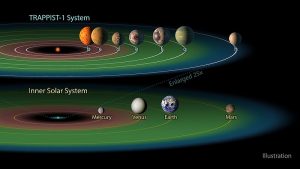
This image shows the similarities between the TRAPPIST system and our solar system (green regions represents habitable zones)
Source: Wikimedia Commons
Very much like our solar system, these planets orbit around a star called TRAPPIST-1, which resembles our sun but is younger, smaller, and less bright. The TRAPPIST system is around 378 trillion kilometers away from us. It would only take us 40 years to get there if we can travel at the speed of light!
Scientists are still looking for more evidence to determine if it is possible for us to live on those planets. Currently, NASA is using the Hubble Space Telescope to scout for the presence of atmosphere and signs of life, such as oxygen.
“There are many more life-supporting planets out there waiting for us to be discovered.” – Royal Sir Martin Rees, Astronomer
Furthermore, this discovery gave promising hope in finding life forms in three of the seven Earth-sized planets. These planets meet some of the basic requirements to support life: a solid planet that orbits around a star that serves as an energy source and the right distance away from the sun so liquid water can run on land. The possibility of aliens existing isn’t zero after all!
(Source: NASA Jet Propulsion Laboratory)
Imagine if all the resources on Earth had been used up and no longer habitable, where will we go? Now we have a target destination, we just need to figure out how to get there.
Although we are still a long way from colonizing a planet, we are certainly on the right track. We are also one step closer to answering the ultimate question that we all wonder, “Are we alone in the universe?”
By: Kevin Chao
Posted in Issues in Science, Science in the News
Tagged aliens, discovery, Second Earth, space, TRAPPIST-1
Imagine living on Mars. Experts have made many cases for why humans should become an interplanetary species. The video below discusses some of the reasons why we should go to Mars. From survival of our species to advancing science, the reasons are plenty. But is it possible to colonize Mars?
(Source: National Geographic, YouTube)
Unlike the moon, humans have never actually set foot on Mars. On this dry, desolate planet, the average surface temperature is -55⁰C. This is attributable to the planet’s thin atmosphere, which is too thin to retain heat, not to mention breathe. A good analogy for living on Mars is that it would be similar to living in Antarctica, but worse.
As arid, frozen and desolate as it may be, Mars is the only known planet besides Earth that could be considered remotely habitable for humans. Recent evidence has proven that there was once water on the planet and that at one point Mars’ climate was similar to that on Earth. Below is an image of Mars proving that there was once flowing water on the planet.
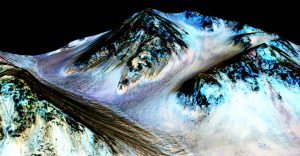
The dark, narrow streaks are inferred to be formed by seasonal flow of water and are roughly the length of a football field. (Source: NASA/JPL-Caltech/Univ. of Arizona)
Although it’s atmosphere is thin, it still offers protection against the Sun’s radiation and the day/night rhythm of Mars is very similar to that on Earth. A day on Mars measures 24 hours, 39 minutes and 35 seconds. In addition, gravity on Mars is 38% of that on Earth, which is believed to be sufficient for the human body to adapt to.
The presence of methane gas on Mars means we could create fuel. The planet’s oxidized soil means we could potentially grow food, and although it’s temperature is frigid, it’s ice means there would be a water source.
Even still, humans won’t be able to live on Mars without the help of technology. It would require complex life-supporting measures and living in artificial environments. NASA believes this is possible and has already selected companies to develop prototypes for deep space habitats. These would be airtight habitats that would allow colonizers to grow food and live in a breathable environment.
It seems entirely possible that humans could sustain life on Mars. With NASA and SpaceX’s continued research and development of technology to send rockets filled with cargo and astronauts to space, it’s only a matter of time before a colony is established on Mars. NASA released a plan outlining the next steps in the journey to Mars.
Elon Musk, founder of SpaceX, has said that he wishes to colonize Mars in the next 40 to 100 years. As he has revealed, this won’t be an easy feat and many challenges lie ahead. Below is a video of Musk discussing what will be needed to successfully colonize Mars.
(Source: The Verge, YouTube)
I think the prospect of establishing a colony on Mars is exciting and the fact that we may see it our lifetime is astounding. I would be open to considering a life on Mars but for now, it’s just a possibility.
Would you live on Mars?
By: Ami Patel
Posted in Issues in Science, Science Communication, Science in the News
Tagged Colonization, Deep Space, Interplanetary, Mars, NASA, space, Space Travel, SpaceX, technology
Although we have built a lot of machines to help us moving things around, such as pickup trucks, cargo planes, ships, etc., we still cannot totally free our hands from carrying heavy stuff. For example, in airports, we must use our hands to unload bags from airplane. Human power are still critical part of transportation.
This is because all porter’s tasks are actually very complex. Cargos are varied from size and shape; routes of transporting involve stairs and slopes. Humans can keep balance easily even when they are carrying cargos walking on bumpy road, and they also can precisely grab or put any random object. Building a machine that replacing these human ability is a challenge.
Scientists are trying so hard for building this kind of machine that can replace porters. Recently, boston dynamic, a robotic technology company, announced their new robot called handle may be a perfect candidate for feature porters.
The new robot can grab a heavy item and move away by it self, just like a human grabbing a grocery bucket and taking it to home.
It has ability to go through complicated routes, such as stairs .
A lot of technologies from different area are involved in this amazing machine. One of the most important technology here is computer vision. It read and process all data read from the robot sensors to tell the robot where he is, where to go and where is the cargo. Automation also plays a important role here; it control all the motor a hydraulic joints. Therefore, robots can move and carry stuff with out falling down.
In the near future, when the price of this kind of robot reduce to a reasonable point. Our transportation system will be more efficient. Products from all over the world will be more achievable. In addition, with such abilities, robots like this can also be used in disaster rescue operations.
Posted in Science in the News
Tagged Automation, cargo, computer vison, Robot, transportation
Can you imagine a smart phone that plays the latest PC games? NVIDIA, a graphics cards company, recently made it possible using a platform called GRID. GRID uses cloud computing technology that allows its users to run accelerated desktops on their phones and laptops. By using these desktops, people can play games and run software with an enhanced speed, because the cloud handles the processing part.
For example, when users start GRID on their smart phones, the selected games or software will be operated on cloud servers; these cloud servers are far away from the users but high-performance. On the same time, the real-time display of the games/software will be transferred from the cloud servers to their phones via the Internet. The real-time inputs, such us keyboard and mouse inputs, will be transferred from the phones to the servers as well. This is not only how GRID works but also how cloud computing works.
As a result, the users feel like the game/software is running on their phones, and the phones perform well. In fact, the mobile devices do not need to actually process since all the processing is done in the cloud. Similarly, users can use GRID to run any software on any device with an Internet access.
In past decades, IT companies and scientists were trying to make mobile devices high-performance, especially when dealing with graphics. However, poor heat radiating and poor battery life are still big problems for mobile devices due to their small physical size. NVIDIA was facing the same problem, but they took a completely different approach to achieve the same goal. In terms of performance and convenience, they succeed.
NVIDIA GRID, and other similar services, gives small companies and low-income people an alternative way to use high-performance devices with an affordable price. For instance, a small company can save money on buying high-end PCs, and low-income people can play games on their low-priced laptops.
However, GRID still has the same lag problems as most online games have. In addition, users need to pay for this service by month or by year. Consequently, playing games and working with a desktop computer is still the best plan. However, if a person travels a lot, using GRID can be a good plan for him/her.
By Max Ma.
What if you were told the “tuna” you’ve been eating all this time isn’t actually tuna? In fact, 59% of tuna sold in the Canadian markets are mislabeled, making it the second most commonly mislabeled seafood, with red snapper sitting at the very top of the list (87% mislabeled).
As seen below, compared to Europe and US, Canadian seafood labels are very much misleading and uninformed for consumers. Luckily, the Canadian Food Inspection Agency is currently reviewing the laws and regulations for proper Sea Food labels.
As alarming as “mystery meat” sounds, it’s not too far off to use as a description for Canadian seafood. “Rockfish” as seen above, is nothing but a common name used for over 100 different species. David Suzuki Foundation is currently holding a petition for seafood labels to include the Scientific name, geographic origin, production methods, and additives used.
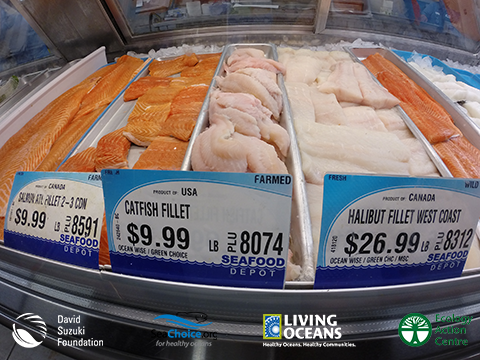
image from http://action2.davidsuzuki.org/seafood-labelling
A study conducted by University of Guelph found that 84% of fish sold as “white tuna” were actually a closely related species called escolar. However, it is known that escolars are unable to digest gempylotoxin (type of wax, similar to mineral oils found in escolars’ diet), which means that when it is consumed, it can cause various digestive problems such as diarrhea and abdominal pain.
Enforcing regulations on seafood providers to have proper labeling will not only help us make healthy choices for ourselves and our families, it will also help us to make environmental and economical friendly choices by supporting locally farmed seafood. Sign the petition today!
Lisa Liang
Clickbait is a major problem in communicating science to the public online.
Popular websites like I Fucking Love Science or Science Daily get tens of millions of views monthly.
Most of these views come from Facebook and other social media that summarize the originals and link to them, creating a market for click-through rates. This has led the pop science blogs to increase boisterous claims in their headlines. Here are a few examples of the most popular clickbait titles last year (which you have probably seen):
These titles are misleading for their content. Most of the articles, while brief, are not necessarily inaccurate; they also link to in-depth articles that give a more accurate and nuanced approach.
So, who cares right? As long as people read the articles, they are okay. But apparently only 30% of people actually read scientific articles before commenting on social media.

Clickbait was recently addressed in a paper by Nathan Hurst at the University of Missouri-Columbia. He studied the effects of clickbait titles on credibility issues regarding the science, article, and aggregator. He realized that titles that relied on clickbait methods (lists, puns, intensity, etc) had a negative effect on the credibility given to all sources.
By making the titles more eye-catching, authors were actually decreasing the perceived validity of their own work, and that of the scientific basis.
This can lead not only to people being mislead to believe something inaccurate, but also to what I call the “Water on Mars” effect. How many news articles have you seen where scientists have apparently discovered water on Mars? Here’s one from 2012, and another from the exact same author and source claiming the same finding three years later.

This has led to mass confusion about the facts. I asked a few of my friends this week whether we’ve actually found water on Mars, and most immediately said yes. When I asked whether we actually found it or found evidence for its existence, they were more hazy. When (if) we actually find a cup of martian water, the public won’t be interested anymore due to saturation.
Similarly, misleading titles can create seemingly conflicting findings by conflating articles to their extreme results. This has had a major effect in the area of climate change, for example is the plankton population decreasing or increasing due to climate change?

It is important to present some nuance in titles or not to present a broad conclusion at all.
This effect is even happening in scientific literature according to a study published by Dr. Gwilym Lockwood at the Max Planck Institute for Psycholinguistics. She found that “article titles with result-oriented positive framing and more interesting phrasing […] get more online attention.”
This suggests that the same factors that affect how widely non-scholarly content is shared extend even to academia.
Here’s John Oliver from Last Week Tonight (HBO, redistributed on YouTube) with jokes about the subject.
– Braydan Pastucha
Posted in Issues in Science, Public Engagement, Science Communication, Science in the News, Uncategorized
Tagged clickbait, ethics, humour, journalism, science, technology
It has always been a mystery as to why humans go through menopause. Chimpanzees and bonobos, whom we share 99% of our DNA with, are still able to reproduce throughout their entire lifespans while humans in their latter part of their lives become infertile. What then, are the reasons for humans becoming infertile as they get older?
Recently BBC and the Atlantic has published an article that can potentially explain the cause of menopause. Menopause is actually a unique trait shared by only three species: humans, killer whales, and pilot whales. Scientists have made many predictions as to why humans may experience menopause, but these predictions end up being extremely difficult to test. One possible explanation for menopause is the Grandmother Hypothesis. The Grandmother Hypothesis suggests that humans have given up their reproductive potential to focus more on caring for their children and grandchildren. In order to prove this hypothesis, we must prove that children are more likely to survive when their grandmother is present compared to when she isn’t. Dr. Lummaa from the University of Turku has published a study that shows that children are 12% more likely to survive adulthood if their grandmother is present.

Elderly Woman Image by Kawahara via Flickr
With the help of advanced technology, humans nowadays are able to live longer than ever, and women often outlive the lifespan of the female reproductive system. However scientists are still finding it. This hypothesis is near impossible to test because humans’ current fertility rate patterns are different from the fertility patterns of our ancestors.
Surprisingly, if we investigated other species that also experience menopause, we could possibly relate this information back to the human species. Darren P. Croft, an animal behaviorist at the University of Exeter, used years of data to reveal why killer whales potentially experience menopause. It became clear that from an evolutionary standpoint, it is a disadvantage for the mother and daughter killer whales to be impregnated at the same time. When both the mother and daughter killer whales reproduce during the same period, the newborns of the older generation have a higher chance of dying, approximately 1.7 times more likely as opposed to the younger generation. According to Croft, “this new research shows that old females go through the menopause because they lose out in reproductive competitive with their own daughters.” This research on killer whales provide us with an explanation for menopause that may possibly apply to humans.
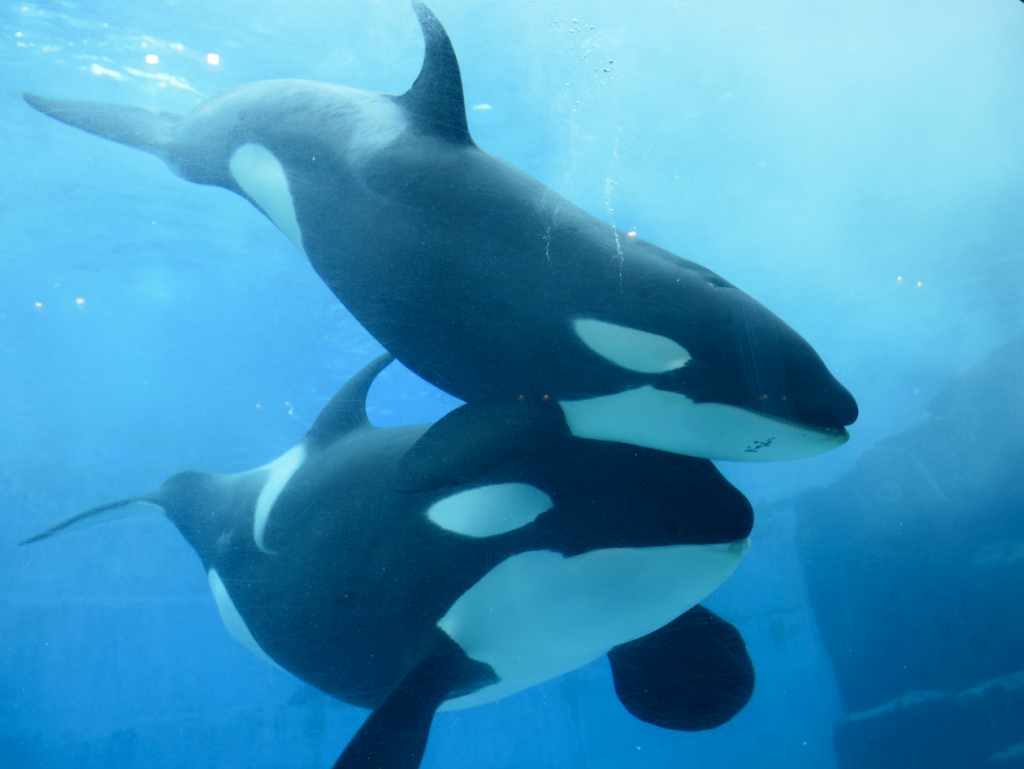
Killer Whales: One of the three species that goes through menopause
image by Grit via Flickr
All in all, it remains a mystery as to why humans go through menopause. Although there are many existing hypotheses that may potentially explain menopause, nothing has been scientifically proven. However, we can gain insight into why humans experience menopause through observing other species.
-Andrew Ting
Posted in Biological Sciences, Science in the News
Click on the image below and take a quick look at the three different labels. Do any of those labels concern you at all? Why is it that, out of the three below, Canadian seafood labels provide consumers with the least amount of information?
In fact, the only labeled information “Rockfish”, is only a common name used for over 100 different species. The scientific name, geographic origin, and production methods are no where to be found. If Europeans are able to provide consumers with all the above details, why shouldn’t Canadian seafood labels show such information?
Enforcing regulations on seafood providers to have proper labeling will not only help consumers determine exactly what they’re buying, but will also help make environmental and economical friendly choices. For instance, knowing that a product is locally farmed will help increase support for local businesses.

image from http://action2.davidsuzuki.org/seafood-labelling
Another benefit mentioned on SeaChoice.org, was that providing information on production methods will help make friendlier environmental decisions; consumers will less likely to pick up a product knowing that its method of production have negative impacts on the ocean.
To help the Canadian Food Inspection Agency in rethinking Canadian Seafood Labeling needs, please head on here to sign the petition show your support for proper labelings before February 23rd 2017!
Lisa Liang
Posted in Science in the News
Tagged canadian health, canadian seafood, environmental awareness, fisheries, health choices, ocean, safety, seafood, seafood labels
In April 2015, an epidemic of the Zika virus disease took Brazil by storm , quickly spreading through South America and parts of North America. The disease was relatively unknown but it was associated with causing microcephaly, a brain defect where a baby’s head is significantly smaller than normal in fetuses of pregnant women with the Zika virus. As time passed with nearing proximity to the 2016 Summer Olympics in Rio de Janeiro, the possibility of contracting the disease caused so much concern that many athletes withdrew from competition.
But the Zika virus is not new.
It was first discovered in 1947 in monkeys of the Zika Forest in Uganda. Since then, there have been small outbreaks in the equatorial Africa and Asia. Unfortunately, due to the mild symptoms of the disease and it’s similarities to dengue, yellow fever and chikungunya, it was often overlooked and underreported until its recent outbreak.
The virus is mainly spread by mosquitoes of the Aedes genus common, namely A. aegypti and A. albopictus. Transmission to a fetus during pregnancy increases the risk of many birth defects such as microcephaly in the newborn child. If that doesn’t sound scary enough, it can also be spread from sexual activity and blood transfusions!
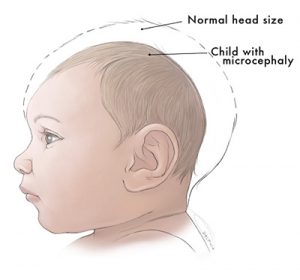
Microcephaly in newborn infants as a result of the Zika virus. Image courtesy of the Boston’s Children’s Hospital.
So what are the symptoms? Infections from the Zika virus will only display mild symptoms at most, including fever, rash, joint pain, pinkeye (conjunctivitis), muscle pain and headache. Symptoms typically subside after a week. Travellers and pregnant women who have recently visited affected areas should be tested for the disease.
The Zika virus is no longer an epidemic by the World Health Organization (WHO) as of November 2016 and it seems like something of the past. But why should we still be concerned about it?
Sadly, just because it is no longer an epidemic doesn’t mean that you shouldn’t be worried. Right now there is no cure for the Zika virus. Vaccines are being developed as we speak, but they probably won’t be available for another 10 years. For now all we can do is take precautions against mosquito bites and avoid travelling to places affected by Zika, especially if you are pregnant.
The problems Zika poses are far from solved. The Zika virus outbreak highlights the just one of the detrimental effects that poor sanitation has on our population. If we don’t solve the problem of managing mosquito populations and inventing new vaccines, we will have persisting human vulnerabilities to mosquito-spread diseases. We will always be at risk of infection to a disease we haven’t cured.
In the meantime, be mindful of your travel plans and check out this video on the Zika virus!
Posted in Biological Sciences, Science Communication, Science in the News
Tagged infection, microcephaly, mosquito, science, virus, Zika